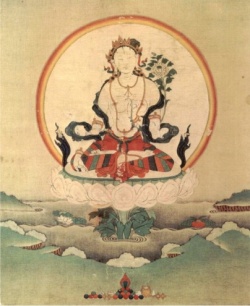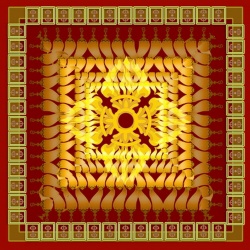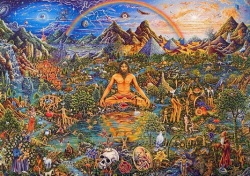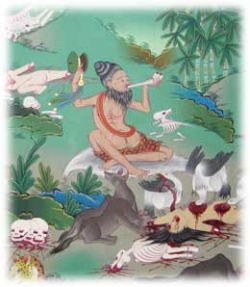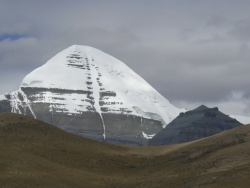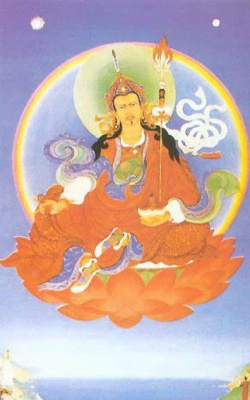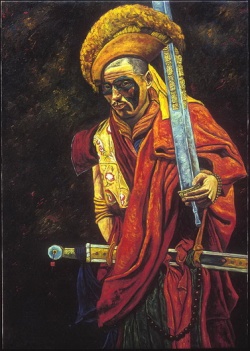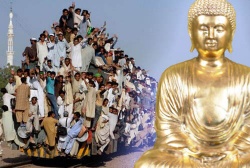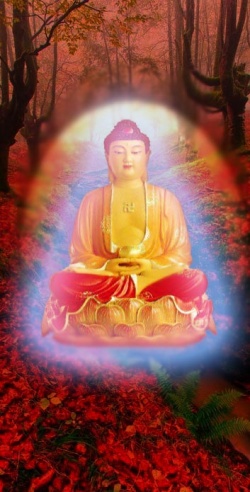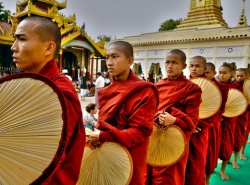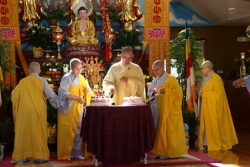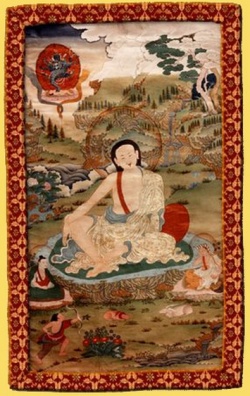Tibetan Buddhism history
When the Buddha passed away, his teachings were collected together by a council of senior disciples. As a result of this, the precious teachings of Dharma were introduced to many countries.
Prior to the introduction of Buddhism to Tibet, it had its own shamanistic religion known as 'Bon'.
In 7th century, Tibet saw the first introduction of Buddhism through the visit of prominent Indian Panditas, who were invited by early Tibetan kings. Early Tibetan kings were keen to promote the Buddhism and were regarded as emanations of bodhisattvas.
The first prominent Dharma King Songsten Gampo (617-650) is believed to be an emanation of Avalokiteshvara. He married a Chinese, a Nepalese and a Tibetan princess. The Chinese Princess Wenshing Kongjo brought with her the Jowo Shakyamuni Buddha statue, the main statue inside the Jokhang Temple in Lhasa and the Nepalese Princess Bhrikuti brought with her the Akshobya statue which is now inside the Ramoche temple in Lhasa. King Srongtsen Gampo sent Thonmi Sambhota to India to study Sanskrit and it was he who invented the Tibetan script to translate Buddhist texts into Tibetan. The King founded the Tradruk Dolma Lhakhang temple in Yarlung Valley and built a palace on Marpori (Red Hill).
The second great Dharma King Trisong Deutsen (740-798), is regarded as an emanation of Manjushri. He made great effort to increase the spread of Buddhist activities and invited Khenchen Bodhisattva, who was one of the more prominent Indian Buddhist monks, to visit Tibet.
Shantarakshita, as he was also known, is the first Indian Buddhist abbot to ordain Tibetans as monks. He served as the royal preceptor of the King Trisong Deutsen. When faced with many obstacles in the construction of the Samye monastery, the King invited the great mystic Padmasambhava to Tibet to subdue the evil and local spirits of Tibet and to clear the way for building Buddhist monasteries. Padmasambhava performed many earth taming rituals, constructed many stupas and played an impressive role as a founding father of Tibetan Buddhism. These three figures, the Great Abbot, Shantarakshita, the Great Vajrayana Master, Padmasambhava and the Great Dharma King Trisong Deutsen are known as khenlop choesum (mkhan slob chos gsum) in Tibetan.
One of the first Tibetans to be ordained as a Buddhist monk by Shantarakshita is Khon Luwang Sung of the Khon family. He hailed from the house of Khon, members of which are believed to have been descendants of celestial gods. He also became one of the twenty five disciples of Padmasambhava. During the early phase of Buddhism in Tibet, it was not distinguishable by traditions or schools. It was simply known as 'religion of the monks' (ben de'i chos) in contrast to 'religion of the Bon' (bon gyi chos). The word 'ben de' is perhaps a corruption of the Sanskrit word 'bante' which means 'venerable' or simply 'monk'.
The third great Dharma King Tri Ralpachen is regarded as an emanation of Vajrapani. He was a devout Buddhist King and did much for the spread of the Dharma and for the standardization of Buddhist texts and translations and hence many Buddhist texts were translated from the Sanskrit into Tibetan.
This period of Buddhism in Tibet is known as 'Early Diffusion of the Doctrine' (bstan pa snga dar). Kawa Paltsek, Chokro Lu'i Gyaltsen and Zhang Nanam De are the three well known Tibetan lotsawas of this period. Tibet, however, experienced the rule of a ruthless king named Langdarma (803-846), who assassinated his elder brother King Tri Ralpachen, caused the destruction of Buddhist monasteries and forcibly disrobed Buddhist monks. The negative effect of this persecution of Buddhism lasted nearly a century and caused the fragmentation of Buddhism into many sects and schools.
From the mid 11th century, Buddhism in Tibet had to rejuvenate itself as what was left of it was mixed with non-Buddhist practices and was open to question and misuse. This gave motivation to send young bright men to India to study Buddhism and the Sanskrit language. Many did not survive the long journey to India but those who returned contributed much to the revival of Buddhism. When the Tibetan Buddhist scholars returned to Tibet, they worked in collaboration with Indian Panditas and formed new schools. This period is known as 'Later Diffusion of the Doctrine' (bstan pa phyi dar). Lochen Rinchen Sangpo (958-1055),
Ngok Lekpe Sherab and his nephew Ngok Loden Sherab (1059-1109) are remembered for their vast contribution to this second phase of Buddhist history in Tibet. The Tibetan royal family of the Yarlung dynasty had collapsed through the assassination of the king Langdarma by Lhalung Paldor. Lha Lama Yeshe Od and his nephew Jangchub Od succeeded in inviting Atisha (982-1054) to Tibet in 1042. This uncle and nephew are descendants of the Yarlung dynasty who remarkably carried out the legacy of their forefathers, albeit Lha Lama Yeshe Od had to die in the prison of a merciless Garlok chieftain. It was Atisha's celebrated disciple Dromtonpa (1008-1064) who founded Radreng monastery. The early followers of this new school were known as 'Sarma' (gsar ma) and later on as Kadampas (bka' gdams pa). The old school was naturally called 'Nyingma' (rning ma).
Collectively all the new schools formed in Tibet were known as 'old Kadampa' (bka' gdams rnying ma) and Gelukpa is known as 'new Kadampa' (bka' gdams gsar ma) as it is the youngest of all schools. Sakyapa is one of the earliest of the new schools founded largely with the inspiration of the four great Tibetan translators: notably Lochen Rinchen Sangpo, Drogmi Lotsawa Shakya Yeshe (993-1074), Goe Lotsawa Khugpa Lhetse and Mal Lotsawa Lodro Drakpa – who were all contemporaries of the great Indian teacher Atisha.
It is not long after this time that Khon Konchok Gyalpo (1034-1102) founded the Sakya monastery in 1073. Sakya is named after the grey coloured landscape and hills surrounding the region. Among the five founding fathers of the Sakyapa tradition, Sakya Pandita (1182-1251) and Choegyal Phakpa (1235-1280) are very famous. Sakya Pandita converted Godan Khan to Buddhism and spearheaded the spread of Buddhism to Mongolia. Sakya Pandita's writings were the first Tibetan author's work to be translated into Chinese and Mongolian.
Choegyal Phakpa travelled to China in 1253 and bestowed the Hevajra empowerment to Kublai Khan, his twenty five ministers and royal family members. Expressing his gratitude, Kublai Khan offered the whole of Tibet to Phakpa as a Mandala offering and thanks-giving and it is from there that the priest patron relationship was forged between Yuan dynasty and the Sakyas.
The Sakyapa lineage has four sub-lineages: each of these four sub-lineages has produced galaxies of great masters over many centuries. Since 1959, all of the above seats were destroyed as were 6000 monasteries in Tibet. From the early 1980s, many monasteries were allowed to be rebuilt, the above seats have all been re-established and there are considerable restoration activities underway (whilst maintaining the study and practice traditions). Since the Tibetans came into exile, these four lineages are headed by the following masters, who have all established their seats in exile.
The Sakyapa lineage of Tibetan Buddhism is blessed with many masters who are manifestations of Bodhisattvas.
The Sakya lineage has four sub-schools: the Sakyapa, founded by Sachen Kunga Nyingpo (1092-1158); the Ngorpa, founded by Ngorchen Kunga Zangpo (1382-1456); the Dzongpa, founded by Dzongpa Kunga Namgyel and the Tsarpa, founded by Tsarchen Losal Gyatso (1502-1566). His Eminence Chogye Trichen Rinpoche, Ngawang Khyenrab Thubten Lekshay Gyatso, was the head of the Tsarpa School of the Sakya tradition of Tibetan Buddhism.
The principal and most comprehensive teaching of the Sakya school is the Lamdre (pronounced 'lamdray'). The term 'Lamdre' means 'the path (lam) with the result (dre).' Lamdre contains instructions and practices covering the whole range of both the sutra and the tantra teachings transmitted by Buddha Shakyamuni. It originated with Virupa (7th century), one of the Indian Buddhist mahasiddhas or supremely accomplished ones. The central teachings and practices within the Lamdre are based on the scripture known as the Hevajra Tantra, the Vajrayana Buddhist tradition of the tantric deity Hevajra.
The Lamdre was brought to Tibet by the Tibetan translator Drogmi Lotsawa in the middle of the 11th century and was later codified in the twelfth century by Sachen Kunga Nyingpo. This teaching has been passed down through an unbroken lineage of masters right to the present day. During the time of the master Muchen Konchok Gyaltsen (1388-1469), the Lamdre was divided into two traditions: the uncommon Lobshe, or private explanation for close disciples, which emphasizes the oral instructions for meditation practice; and the more commonly given Tsogshe, the explanation for the general assembly.
The essence of the Lamdre is known as the view of the 'inseparability of samsara and nirvana' (khorde yerme), which refers to the inseparability of worldly existence and enlightenment. There is no abandoning of samsara in order to achieve nirvana, as the mind is the root of both. Once mind has been understood to be the root of both, it follows that nirvana is just a transformation of samsara. Realizing this inseparability is the key to attaining enlightenment through the Lamdre teachings.
The Lamdre is known as a vast, profound, and complete path to enlightenment.
It is divided into two sections:
the preliminary section and the tantric section.
The preliminary section contains instructions and teachings of the Mahayana Buddhist tradition and focuses on the 'three modes of appearance' or 'three modes of perception' (nang sum), sometimes referred to simply as the 'three visions':
the impure perception, the perception of experience, and pure perception.
The tantric section contains the esoteric teachings, especially the teachings on the 'three tantras' or 'three continuums' (gyu sum). In any generation, there are only a few lineage holders of the Lamdre within the Sakya tradition.
The Tsarpa branch of the Sakya school was founded by Tsarchen Losal Gyatso (1502-1556), who established the Dar Drangmoche Monastery in Tsang Province in Central Tibet. Tsarchen was a master of extraordinary realisation who beheld pure visions of Guru Padmasambhava, Vajrayogini, Chakrasamvara, Kalachakra, Yamantaka and numerous other masters and tantric deities. He met them just as one would meet another person, face to face. The uncommon Path with the Result (Lamdre Lobshe) was transmitted and elaborated on by Tsarchen, as was the uncommon Vajrayogini practice lineage of the Sky-going Goddess of Naropa]] (Naro Khachoma).
The Tsarpa lineage is renowned for maintaining all the highly prized uncommon and most esoteric meditation lineages of the Sakya school – so Tsarpa masters have traditionally been represented as the holders of the practice lineage within the Sakya tradition.
The precious practice lineages for which the Tsarpa are known include the uncommon Path with the Result (Lamdre Lobshe), the uncommon Vajrayogini of Naropa, the greater and lesser Mahakala, the Thirteen Golden Dharmas, the Kalachakra of the Jonangpas and many others.
The late Chogye Trichen Rinpoche was the pptwenty-fifth patriarch of Phenpo Nalendra Monastery]] and was the head Lama of the Tsarpa branch of the Sakya school. Until recently, Rinpoche resided in Kathmandu, Nepal.
Phenpo Nalendra, one of the main monasteries of the Tsarpa tradition, is located in the Phenyul Valley just north-east of Lhasa in central Tibet. Founded in 1435 by one of the great masters in the history of the Sakya tradition, Rongton Sheja Kunrig (1367-1449), Nalendra is one of the most important Sakya monasteries, with branch monasteries in various parts of Tibet, from Tsang to the Amdo region.
Named after that incomparable centre of classical Buddhist learning (Nalendra Monastery in Bihar, India), during its first twenty years Nalendra grew to house 3,000 monks. 'Rgyun gyi dbang po' (the Tibetan word for Nalendra) means "the river of power" and describes well that over the course of more than 500 years, Phenpo Nalendra came to be one of the greatest Sakya Shedras (colleges) in U district of central Tibet.
The monastery generally had between 700 to 1,000 resident monks, and was also home to thousands of visiting monks who were studying at the various colleges. As a stronghold of the esoteric practice lineage within the Sakya tradition, Nalendra became the principal monastery of the Tsarpa branch, due to the extraordinary masters of the practice lineage who were its throne holders.
It was also a repository of the teachings of all the eight great practice lineages of Tibet and thus was a center of the broader, non-sectarian approach to Buddhist practice. As just one recent example of this, the previous Chogye Trichen, throne holder of Nalendra, was a close disciple of the Fifteenth Karmapa, Khakyab Dorje, receiving in particular many teachings in the tradition of the Great Perfection (dzogpa chenpo), such as the Precious Collection of Revealed Treasures (Rinchen Terdzod).
Great meditators from all branches of the Sakya school went to Nalendra Monastery for practice and retreat. In modern times, prior to 1959, they came to train in the practice of retreat at Nalendra as disciples of Dampa Rinpoche, Zhenpen Nyingpo of Ngor, Zimwok Rinpoche of Nalendra, and Chogye Trichen Rinpoche. There were many retreat centres in the surrounding mountains, including two special hermitages where yogis remained in lifetime retreat.
Whenever one of these yogis passed away, the event was inevitably accompanied by the appearance of rainbows, miraculous signs and wonders. A monk who came out of Tibet with Chogye Rinpoche remarked that this was so commonplace that the monks would say: "Well, of course he had signs, he stayed in lifelong retreat!' Nalendra was renowned in Tibet for the practice of the female tantric deity Vajrayogini.
There were said to be generation after generation of yogis who accomplished the fruition of 'going to the celestial realms' (khacho) through the practice of Vajrayogini in the form of Naro Khachoma. Through Vajrayogini, they were able to transfer to the paradise of Khechara, the Akanishta pure realm of the Sambogakaya buddha-fields.
Some dissolved their physical bodies into rainbow light at the time of death. Some left this world with their physical bodies and accompanied Vajrayogini into the sky, disappearing into space as they journeyed to her pure realm. Some met her whilst moving amongst people and departed with her to the Khechara pure land; and for some, her coral staircase appeared in their meditation rooms and they ascended to Vajrayogini's pure land.
Many of the Chogye Trichen Rinpoches have displayed the signs of Khechara. The previous Chogye Trichen, Rinchen Khyentse Wangpo (1869-1927), manifested signs of phowa, the transference of consciousness to Vajrayogini's paradise, at the time of his passing from this world.
Only recently, when the Khenpo Tsultim Gyalsten was cremated in Nalendra many bone relics bearing dots of sindura powder were discovered and his heart, tongue and eye remained un-burnt. After the relics were consecrated, there was a spectacular snowfall of lotus flowers, dharma wheels and dharmakara. Monks spread their robes and these wonderful symbols fell onto them –this has been captured on video camera.
The founder of Nalendra monastery, Rongton Sheja Kunrig, also known as Kunkhyen Rongton, was born in eastern Tibet in Gyalmo Rong in 1367. Guided by prophecies, as well as on his activities, Rongton was regarded as an emanation of Maitreya, the next Buddha of our fortunate eon. His earlier incarnations included the Indian acharya Haribhadra, Pandita Kamalashila, Phadampa Sangye and many others. He became known as one of the 'six gems of the Sakya tradition' in recognition of his unparalleled mastery of the sutra tradition in general, the scriptures of Prajnaparamita and the teachings of Maitreya in particular. His Eminence Chogye Trichen Rinpoche received Rongton's teachings on the Prajnaparamita from the great bodhisattva Khunu Lama Tenzin Gyaltsen, as well as from other masters.
Rongton wrote three hundred works, ranging from eulogies and philosophical treatises to commentaries on the tantras. He was known to have realised, at the very least, the sixth bodhisattva level of spiritual attainment (bhumi), and it is said that he realized the truth of the nature of reality (Dharmata). According to his biographies, Rongton could send forth multiple emanations of himself, resurrect deceased beings and fly in space. As he entered the higher stages of realization, he became more and more childlike. He had liberated conceptual thinking and so behaved and spoke with the innocence of a child. He was a great bodhisattva and a great tantric master.
A contemporary of Tsongkhapa, the founder of the Gelug school, Rongton was the first to challenge the Gelug philosophical teachings. His students Gorampa and Shakya Chogden composed penetrating refutations of Tsongkhapa's interpretation of Madhyamika. Nonetheless, Tsongkhapa held Rongton in the highest esteem, revealing to his student Khedrup-je that he regarded Rongton as none other than the bodhisattva Maitreya.
At the age of eighty-four, Rongton announced that he was to depart for Tushita heaven, where the bodhisattva Maitreya dwells. A few days later he passed away, dissolving into Maitreya. Rongton manifested one of the varieties of rainbow body at his passing, whereby the physical form dissolves into a body of rainbow light. His body shrank to a very small size and became extremely light. Before it completely disappeared, it suddenly stopped shrinking and then turned into a jewel relic, becoming again somewhat heavier. The tradition is that Rongton's fruition of rainbow body was probably a result of the practice of Vajrayogini even though, as a manifestation of bodhisattva Maitreya, many means of manifesting the rainbow body were available to him.
Following the initial era of the founding of Nalendra, Dakpo Tashi Namgyel became the successor to Rongton followed by Gewa Gyalsten and Gung-ru. After the 7th abbot of Nalendra, some misfortunes and outbreaks of illness befell Nalendra monastery. In response, the twenty-first Sakya throne holder, Dagchen Lodro Gyaltsen (1444-1495) determined that the abbot and throne holder should not be solely a great tantric adept, but that they should have attained the level of a bodhisattva, in accordance with the Mahayana Buddhist vehicle.
Thus, Khyenrab Choje (1436-1497) of the Zhalu [[Kushang branch of the ancient Che family was installed as the throne holder and eighth abbot of the monastery. Khyenrab Choje was the first Chogye Trichen and was succeeded by seventeen holders of the Chogye Trichen title, all of whom came from the Che family, from the 'bone lineage' of patrilineal descent. This included Zimwok Tenzin Nyendrak. From the time of Khyenrab Choje until the Chinese invasion of Tibet, Nalendra suffered no further obstacles.
The Nalendra throne holder's title, Chogye Trichen, is composed of two terms: chogye, 'eighteen'; and trichen, 'great throne.' It is said that the name Chogye is derived after the passing away of Khyenrab Choje, who was the first holder of the throne at Nalendra to come from the Zhalu Kushang family. Khyenrab Choje was invited to go to China by the Chinese emperor. As he was unable to go he sent his nephew, Jamyang Donyo Gyaltsen, as his representative.
Through this nephew, the emperor bestowed the title of Chogye Trichen on the throne holder of Nalendra, lauding eighteen (chogye) exalted spiritual qualities he wished to recognize in Khyenrab Choje. The 'eighteen' in this title also alludes to the 18th of the 12th lunar month which celebrates the anniversary of Khyenrab Choje. This day is also marked by the Chogye Tripa (throne holder) bestowing the Goddess Parnashavari empowerment, which is given annually to remember and honour the anniversary of the ending of the epidemic that devastated Nalendra.
The Chogye Trichens received many offerings from the Chinese emperors. One offering was the ceremonial hat, a copy of which Chogye Rinpoche is often seen wearing in photos. This hat is replete with symbolism of Vajrayana Buddhism in general and of the deity Hevajra in particular. The famous hat was named 'only ornament of the world" by the emperor. Subsequent holders of the throne of the Chogye Trichen continued to receive many honours from the Chinese emperors.
Whilst in meditation retreat in the Potala in Lhasa, as a result of his spiritual practice, Khyenrab Choje beheld the sustained vision of the female tantric deity Vajrayogini against the backdrop of the cliffs of Drak Yerpa and received extensive teachings and initiations directly from her. Two forms of Vajrayogini appeared out of the face of the rocks at Drak Yerpa, one red and the other white, and together they bestowed the Kalachakra initiation on Khyenrab Choje.
When asked if there was any proof of this, his attendant showed the kusha grass Khyenrab Choje had brought back with him from the initiation. It was unlike any kusha grass found in this world, with rainbow lights sparkling up and down the length of the dried blades of grass. This direct lineage from Vajrayogini is the shortest, the most recent, and the most direct lineage of Kalachakra that exists in this world. In addition to being known as an emanation of Manjushri, Khyenrab Choje had previously been born as many of the Rigden kings of Shambhala as well as numerous Buddhist masters of India. These are some indications of his unique relationship to the Kalachakra tradition.
Since the time of Khyenrab Choje, all the Chogye Trichens have come from the Zhalu Kushang branch of the Che family, so the lineage of the Chogye Trichens has been patrilineal, held by descendants of the 'bone lineage' of the Kushang family. The ongoing emanation of bodhisattvas through the 'bone lineage' is found in some traditions of Tibetan Buddhism, and 'bone lineage' emanations are very highly respected for many reasons.
This is particularly so when the family is originally descended from the celestial gods. In this regard, the Che family shares a similar history with the Khon family of His Holiness Sakya Trizin, as the story of both families begins with the original descent of the gods of clear light (prabhashvara-devas) into our world. The late His Eminence Chogye Trichen, Ngawang Khyenrab Lekshay Gyatso, was the eighteenth Nalendra throne holder in the lineage, beginning with Khyenrab Choje, to have come from the Zhalu Kushang family.
In her Great Commentary on Chod, the famed female master Machig Lapdron prophesied three future emanations of Maitreya who would appear in Rongton's lineage, each of whose names would contain the word khyen or 'knowledgeable.' These are Khyenrab Choje (1438-97), Khyenrab Jampa (1633-1703), and Rinchen Khyentse Wangpo (1869-1927).
All three held the title of Chogye Trichen, throne holder of Nalendra Monastery. Rinchen Khyentse Wangpo, the third Maitreya incarnation prophesied by Machig Lapdron, was the last Chogye Trichen before the late throne holder, Khyenrab Lekshay Gyatso (who was also the nephew of Rinchen Khyentse Wangpo). The late Chogye Rinpoche had consecrated a twelve-metre statue of Maitreya at his monastery in Boudh Nath, Nepal, maintaining the tradition of the blessings of his lineage coming down through the khyen incarnations of Maitreya.
